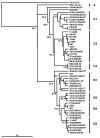Molecular epidemiology of human enterovirus 71 strains and recent outbreaks in the Asia-Pacific region: comparative analysis of the VP1 and VP4 genes
- PMID: 12702227
- PMCID: PMC2957976
- DOI: 10.3201/eid0904.020395
Molecular epidemiology of human enterovirus 71 strains and recent outbreaks in the Asia-Pacific region: comparative analysis of the VP1 and VP4 genes
Abstract
This study provides a comprehensive overview of the molecular epidemiology of human enterovirus 71 (HEV71) in the Asia-Pacific region from 1997 through 2002. Phylogenetic analysis of the VP4 and VP1 genes of recent HEV71 strains indicates that several genogroups of the virus have been circulating in the Asia-Pacific region since 1997. The first of these recent outbreaks, described in Sarawak (Malaysian Borneo) in 1997, was caused by genogroup B3. This outbreak was followed by large outbreaks in Taiwan in 1998, caused by genogroup C2, and in Perth (Western Australia) in 1999, where viruses belonging to genogroups B3 and C2 cocirculated. Singapore, Taiwan, and Sarawak had HEV71 epidemics in 2000, caused predominantly by viruses belonging to genogroup B4; however, large numbers of fatalities were observed only in Taiwan. HEV71 was identified during an epidemic of hand, foot and mouth disease in Korea; that epidemic was found to be due to viruses constituting a new genogroup, C3.
Figures






References
-
- Schmidt NJ, Lennette EH, Ho HH. An apparently new enterovirus isolated from patients with disease of the central nervous system. J Infect Dis. 1974;129:304–9. - PubMed
-
- Melnick JL. Enterovirus type 71 infections: a varied clinical pattern sometimes mimicking paralytic poliomyelitis. Rev Infect Dis. 1984;6(Suppl 2):S387–90. - PubMed
-
- Alexander JP, Baden L, Pallansch MA, Anderson LJ. Enterovirus 71 infections and neurologic disease—United States, 1977–1991. J Infect Dis. 1994;169:905–8. - PubMed
Publication types
MeSH terms
LinkOut - more resources
Full Text Sources
Miscellaneous
